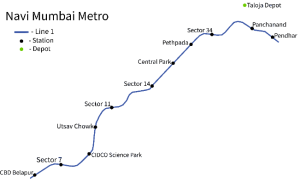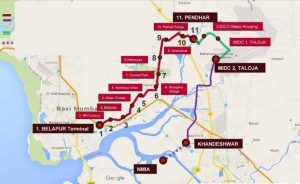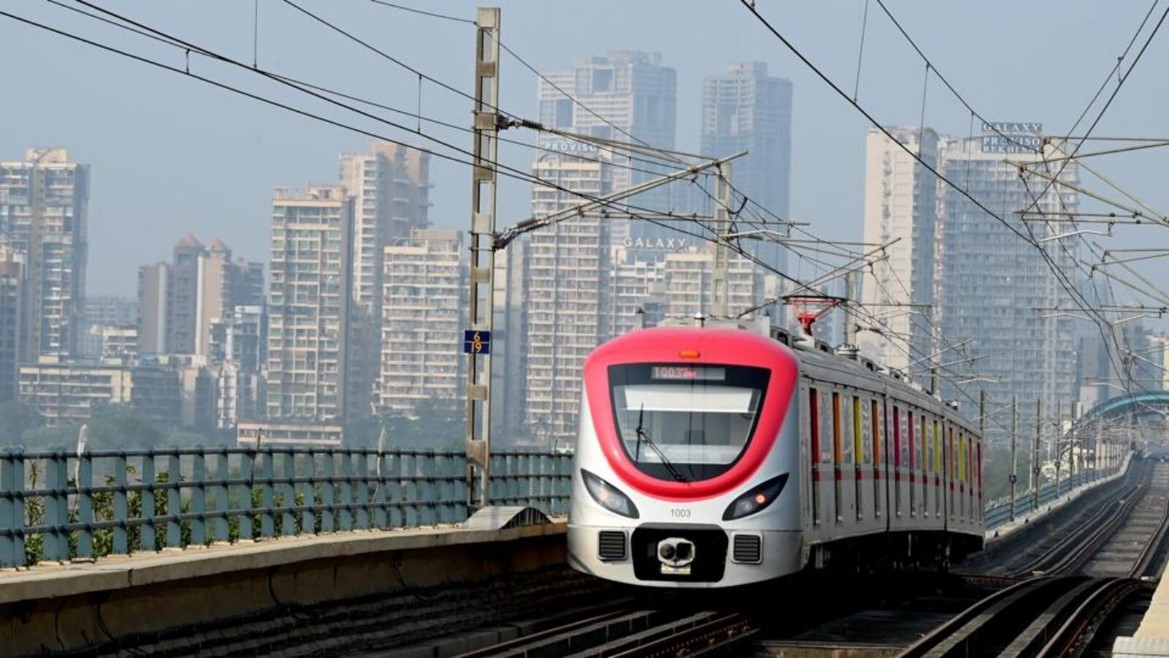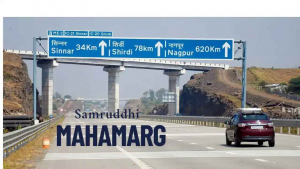Introduction: Why Is the Navi Mumbai Metro Line a Game-Changer for the Region?
Navi Mumbai has always been known for its planned infrastructure, wide roads, cleaner environment, and a far more organized development pattern compared to Mumbai. But for decades, one major gap remained: the lack of a dedicated, high-capacity rapid transit network that truly matched the scale and pace of its growth. That long-awaited dream is now becoming a reality with the launch and expansion of the Navi Mumbai Metro Line.
Developed by CIDCO (City and Industrial Development Corporation), the Navi Mumbai Metro is designed to seamlessly connect residential nodes, commercial hubs, industrial pockets, and eventually, the upcoming Navi Mumbai International Airport. With Line 1 already operational and phases 2, 3, and 4 progressing, the metro is set to drastically reduce travel time, boost real estate growth, and ease road traffic that was becoming increasingly overwhelming.
This blog takes you through the complete Navi Mumbai Metro route, station list, opening date, latest news, Navi Mumbai Metro map, future expansion plans, timings, fares, and everything else you need to know. Written systematically in your preferred style, this piece serves as the ultimate guide for commuters, investors, and homebuyers exploring Navi Mumbai’s growing potential.
What Is the Navi Mumbai Metro Line and Why Was It Developed?
CIDCO Navi Mumbai Metro is a modern, elevated rapid transit system planned across four major lines covering key nodes such as Belapur, Kharghar, Pendhar, MIDC, Taloja, Vashi, Nerul, and eventually extending to the Navi Mumbai Airport. The vision behind this project is clear: to offer a smooth, efficient, and future-ready mass transit solution to one of India’s fastest-growing urban regions.
Key Objectives of Navi Mumbai Metro Line
- To reduce dependency on road travel and ease congestion at major junctions.
- To provide a high-speed, high-capacity transit link across developed and developing nodes.
- To improve last-mile connectivity with feeder buses, autos, and future water transport routes.
- To seamlessly link residential pockets with IT parks, educational hubs, and commercial clusters.
- To support future demand arising from the Navi Mumbai International Airport.
What Is the Navi Mumbai Metro Route and How Does It Strengthen Connectivity?
The Navi Mumbai Metro route for Line 1 runs between Belapur and Pendhar, covering 11 stations across some of the most active and rapidly developing nodes. It interconnects major residential clusters like Kharghar and Taloja with business and industrial hubs, ensuring smooth movement for daily commuters.
Highlights of the Route
- Fully elevated corridor.
- Connects Belapur railway station to Pendhar via Kharghar.
- Designed to ease congestion on the Sion-Panvel Highway and key internal roads.
- Carries a strong potential to support future expansion toward the Navi Mumbai Airport.
In future, the network will grow much beyond Line 1, as Navi Mumbai Metro Line 2, Line 3, and Line 4 will penetrate more nodes and provide deeper connectivity.
What Does the Navi Mumbai Metro Station List Include?

Here is the complete Navi Mumbai Metro station list for Line 1:
- Belapur Terminal
- Sector 7
- Sector 11
- CBD Belapur
- Science Park
- Utsav Chowk
- Belpada
- Sector 14
- Kharghar Village
- Taloja
- Pendhar Terminal
What Makes These Stations Strategic?
- Stations like Belapur Terminal and CBD Belapur connect seamlessly with the Harbour Line.
- Science Park and Utsav Chowk stations lie in dense residential zones, ensuring strong ridership.
- Kharghar Village and Taloja stations will boost connectivity for emerging residential hubs.
- Pendhar will act as a major interchange point once Phase 2 extends beyond Taloja.
The station placements reflect CIDCO’s long-term approach: ensure that the metro supports both current population density and future expansion pockets.
What Is the Navi Mumbai Metro Opening Date and When Did Operations Begin?
After multiple delays caused by contractor issues, changes in safety requirements, and the pandemic, CIDCO successfully completed the required trials and certifications. Navi Mumbai Metro Line 1 officially opened to the public in late 2023.
Why Was the Opening Significant?
- Line 1 became the region’s first operational metro corridor.
- It allowed commuters from Kharghar and Taloja to travel faster and more efficiently.
- It signaled the beginning of an organized transit revolution in Navi Mumbai.
Upcoming phases are now progressing toward their respective target timelines.
What Are the Latest Updates and Navi Mumbai Metro News?

The latest Navi Mumbai Metro news largely revolves around expansion progress, airport connectivity planning, and increased ridership patterns across Line 1.
Important Developments
- CIDCO has accelerated work on Navi Mumbai Metro Phase 2 to connect Taloja MIDC to Khandeshwar.
- Feasibility work for Line 2, 3, and 4 extensions has begun.
- Integration plans with bus terminals and future airport shuttle services are in discussion.
- Monthly passes and digital ticketing options are being enhanced for smoother travel.
- New multi-modal hubs may be introduced at key stations in the future.
The overall picture is clear: Navi Mumbai Metro is moving steadily toward becoming a multi-line, fully integrated urban transit system.
Also Read:- CIDCO to Auction 30 Plots Near Navi Mumbai International Airport: Residential, Commercial & Bungalow Spaces Up for Grabs
What Is the Navi Mumbai Metro Map and How Does It Help Passengers?

The Navi Mumbai Metro map gives commuters a clear snapshot of the entire Line 1 alignment, station locations, interchange points, and future expansion routes. It helps passengers plan their travel, understand last-mile connectivity, and gauge upcoming development around each node.
Key Features of the Navi Mumbai Metro Map
- Displays station-to-station sequence along Line 1.
- Marks interchange potential with railway and bus routes.
- Outlines alignment for Line 2, Line 3, and Line 4.
- Shows proximity to landmarks like Utsav Chowk, CIDCO nodes, industrial hubs, and upcoming Navi Mumbai Airport.
What Are Navi Mumbai Metro Timings and How Frequently Do Trains Run?

The Navi Mumbai Metro timings typically operate from early morning to late evening, ensuring seamless connectivity for office commuters, students, and local residents.
General Timings
- Services begin around 6:00 AM.
- Last trains operate around 10:00 PM.
- Frequency varies between 10 to 15 minutes based on peak and non-peak hours.
As ridership increases, service frequency may be further improved.
How Do You Book Navi Mumbai Metro Ticket Online?

CIDCO and metro authorities are increasingly promoting digital ticketing for faster access and shorter queues. Passengers can now book their Navi Mumbai Metro ticket online via dedicated apps and payment platforms.
Ticketing Options
- QR-based tickets on mobile apps.
- Smart cards for daily commuters.
- Monthly passes for regular travel.
- In-station ticket vending machines.
Digital ticketing is expected to become the primary mode as ridership continues to rise.
Also Read:- How to Check RERA Registered Projects in Navi Mumbai in 2025
What Is the Navi Mumbai Metro Fare and Monthly Pass Price?
The fare structure is designed to be affordable for working professionals, students, and daily commuters. Pricing varies based on distance and number of stations travelled.
General Fare Overview
- Minimum fare starts from around 10 to 20 rupees.
- Maximum fare ranges between 40 to 60 rupees depending on the route.
- Navi Mumbai Metro monthly pass price is kept economical to support daily ridership.
This simple and transparent fare system ensures accessibility for all sections of society.
What Is Navi Mumbai Metro Phase 2 and How Will It Transform Connectivity?
Navi Mumbai Metro Phase 2 focuses on extending the line deeper into Taloja MIDC, Khandeshwar, and eventually connecting to nodes that lie closer to the proposed airport influence zone.
Key Objectives of Phase 2
- Provide faster access for workers in Taloja MIDC.
- Link residential areas near Khandeshwar with Belapur and Kharghar.
- Strengthen integration with the upcoming airport infrastructure.
Phase 2 is expected to significantly drive residential and commercial development across this belt.
What Is the Plan for Navi Mumbai Metro Line 2, 3 and 4?
The upcoming Navi Mumbai Metro Line 2, Line 3, and Line 4 will further widen the transport network and bring nodes like Vashi, Nerul, Panvel, and the Navi Mumbai Airport under metro coverage.
Expansion Vision
- Line 2 will cover Taloja MIDC to Khandeshwar.
- Line 3 will extend from Khandeshwar to the future airport terminal.
- Line 4 is expected to link emerging growth pockets with developed nodes.
Once operational, Navi Mumbai will offer one of the most comprehensive metro networks in India.
How Will the Navi Mumbai Airport Boost Metro Requirements?
With the Navi Mumbai International Airport nearing completion, demand for rapid transit is expected to surge. The metro system is being carefully designed to support both airport passengers and the massive commercial ecosystem that will develop around it.
Expected Impact
- Dedicated airport metro station.
- Faster last-mile connectivity for flyers.
- Increased real estate value in surrounding nodes.
- Boost in employment zones and commercial developments.
The metro-airport combination will reshape the entire growth trajectory of Navi Mumbai.
Conclusion: Why Does the Navi Mumbai Metro Line Unlock a New Era of Connectivity?
The Navi Mumbai Metro is not just another transport project. It represents a major urban shift in how people travel, how real estate grows, and how economic activity spreads across one of India’s most promising metropolitan regions. Line 1 has paved the way for a more sustainable, efficient, and accessible future, while the upcoming Lines 2, 3, and 4 will further unlock the full potential of Navi Mumbai as a world-class urban ecosystem.
From improved last-mile connectivity to affordable fares, from reduced traffic to accelerated airport development, the Navi Mumbai Metro promises to redefine mobility for lakhs of residents. And for homebuyers and investors, infrastructure development of this scale always translates to long-term benefits and rising property value.
At Housiey, we help homebuyers stay ahead of major real estate and infrastructure developments. If you want to explore the best property options across Navi Mumbai’s fastest-growing nodes, we offer transparent guidance, verified insights, and a trustworthy homebuying experience.
To understand how Mumbai’s larger metro ecosystem is evolving, make sure to read our detailed blog on Mumbai Metro Line 3.
FAQs
Introduction: Why Is the Navi Mumbai Metro Line a Game-Changer for the Region?
Navi Mumbai has always been known for its planned infrastructure, wide roads, cleaner environment, and a far more organized development pattern compared to Mumbai. But for decades, one major gap remained: the lack of a dedicated, high-capacity rapid transit network that truly matched the scale and pace of its growth. That long-awaited dream is now becoming a reality with the launch and expansion of the Navi Mumbai Metro Line.
Developed by CIDCO (City and Industrial Development Corporation), the Navi Mumbai Metro is designed to seamlessly connect residential nodes, commercial hubs, industrial pockets, and eventually, the upcoming Navi Mumbai International Airport. With Line 1 already operational and phases 2, 3, and 4 progressing, the metro is set to drastically reduce travel time, boost real estate growth, and ease road traffic that was becoming increasingly overwhelming.
This blog takes you through the complete Navi Mumbai Metro route, station list, opening date, latest news, Navi Mumbai Metro map, future expansion plans, timings, fares, and everything else you need to know. Written systematically in your preferred style, this piece serves as the ultimate guide for commuters, investors, and homebuyers exploring Navi Mumbai’s growing potential.
What Is the Navi Mumbai Metro Line and Why Was It Developed?
CIDCO Navi Mumbai Metro is a modern, elevated rapid transit system planned across four major lines covering key nodes such as Belapur, Kharghar, Pendhar, MIDC, Taloja, Vashi, Nerul, and eventually extending to the Navi Mumbai Airport. The vision behind this project is clear: to offer a smooth, efficient, and future-ready mass transit solution to one of India’s fastest-growing urban regions.
Key Objectives of Navi Mumbai Metro Line
- To reduce dependency on road travel and ease congestion at major junctions.
- To provide a high-speed, high-capacity transit link across developed and developing nodes.
- To improve last-mile connectivity with feeder buses, autos, and future water transport routes.
- To seamlessly link residential pockets with IT parks, educational hubs, and commercial clusters.
- To support future demand arising from the Navi Mumbai International Airport.
What Is the Navi Mumbai Metro Route and How Does It Strengthen Connectivity?
The Navi Mumbai Metro route for Line 1 runs between Belapur and Pendhar, covering 11 stations across some of the most active and rapidly developing nodes. It interconnects major residential clusters like Kharghar and Taloja with business and industrial hubs, ensuring smooth movement for daily commuters.
Highlights of the Route
- Fully elevated corridor.
- Connects Belapur railway station to Pendhar via Kharghar.
- Designed to ease congestion on the Sion-Panvel Highway and key internal roads.
- Carries a strong potential to support future expansion toward the Navi Mumbai Airport.
In future, the network will grow much beyond Line 1, as Navi Mumbai Metro Line 2, Line 3, and Line 4 will penetrate more nodes and provide deeper connectivity.
What Does the Navi Mumbai Metro Station List Include?

Here is the complete Navi Mumbai Metro station list for Line 1:
- Belapur Terminal
- Sector 7
- Sector 11
- CBD Belapur
- Science Park
- Utsav Chowk
- Belpada
- Sector 14
- Kharghar Village
- Taloja
- Pendhar Terminal
What Makes These Stations Strategic?
- Stations like Belapur Terminal and CBD Belapur connect seamlessly with the Harbour Line.
- Science Park and Utsav Chowk stations lie in dense residential zones, ensuring strong ridership.
- Kharghar Village and Taloja stations will boost connectivity for emerging residential hubs.
- Pendhar will act as a major interchange point once Phase 2 extends beyond Taloja.
The station placements reflect CIDCO’s long-term approach: ensure that the metro supports both current population density and future expansion pockets.
What Is the Navi Mumbai Metro Opening Date and When Did Operations Begin?
After multiple delays caused by contractor issues, changes in safety requirements, and the pandemic, CIDCO successfully completed the required trials and certifications. Navi Mumbai Metro Line 1 officially opened to the public in late 2023.
Why Was the Opening Significant?
- Line 1 became the region’s first operational metro corridor.
- It allowed commuters from Kharghar and Taloja to travel faster and more efficiently.
- It signaled the beginning of an organized transit revolution in Navi Mumbai.
Upcoming phases are now progressing toward their respective target timelines.
What Are the Latest Updates and Navi Mumbai Metro News?

The latest Navi Mumbai Metro news largely revolves around expansion progress, airport connectivity planning, and increased ridership patterns across Line 1.
Important Developments
- CIDCO has accelerated work on Navi Mumbai Metro Phase 2 to connect Taloja MIDC to Khandeshwar.
- Feasibility work for Line 2, 3, and 4 extensions has begun.
- Integration plans with bus terminals and future airport shuttle services are in discussion.
- Monthly passes and digital ticketing options are being enhanced for smoother travel.
- New multi-modal hubs may be introduced at key stations in the future.
The overall picture is clear: Navi Mumbai Metro is moving steadily toward becoming a multi-line, fully integrated urban transit system.
Also Read:- CIDCO to Auction 30 Plots Near Navi Mumbai International Airport: Residential, Commercial & Bungalow Spaces Up for Grabs
What Is the Navi Mumbai Metro Map and How Does It Help Passengers?

The Navi Mumbai Metro map gives commuters a clear snapshot of the entire Line 1 alignment, station locations, interchange points, and future expansion routes. It helps passengers plan their travel, understand last-mile connectivity, and gauge upcoming development around each node.
Key Features of the Navi Mumbai Metro Map
- Displays station-to-station sequence along Line 1.
- Marks interchange potential with railway and bus routes.
- Outlines alignment for Line 2, Line 3, and Line 4.
- Shows proximity to landmarks like Utsav Chowk, CIDCO nodes, industrial hubs, and upcoming Navi Mumbai Airport.
What Are Navi Mumbai Metro Timings and How Frequently Do Trains Run?

The Navi Mumbai Metro timings typically operate from early morning to late evening, ensuring seamless connectivity for office commuters, students, and local residents.
General Timings
- Services begin around 6:00 AM.
- Last trains operate around 10:00 PM.
- Frequency varies between 10 to 15 minutes based on peak and non-peak hours.
As ridership increases, service frequency may be further improved.
How Do You Book Navi Mumbai Metro Ticket Online?

CIDCO and metro authorities are increasingly promoting digital ticketing for faster access and shorter queues. Passengers can now book their Navi Mumbai Metro ticket online via dedicated apps and payment platforms.
Ticketing Options
- QR-based tickets on mobile apps.
- Smart cards for daily commuters.
- Monthly passes for regular travel.
- In-station ticket vending machines.
Digital ticketing is expected to become the primary mode as ridership continues to rise.
Also Read:- How to Check RERA Registered Projects in Navi Mumbai in 2025
What Is the Navi Mumbai Metro Fare and Monthly Pass Price?
The fare structure is designed to be affordable for working professionals, students, and daily commuters. Pricing varies based on distance and number of stations travelled.
General Fare Overview
- Minimum fare starts from around 10 to 20 rupees.
- Maximum fare ranges between 40 to 60 rupees depending on the route.
- Navi Mumbai Metro monthly pass price is kept economical to support daily ridership.
This simple and transparent fare system ensures accessibility for all sections of society.
What Is Navi Mumbai Metro Phase 2 and How Will It Transform Connectivity?
Navi Mumbai Metro Phase 2 focuses on extending the line deeper into Taloja MIDC, Khandeshwar, and eventually connecting to nodes that lie closer to the proposed airport influence zone.
Key Objectives of Phase 2
- Provide faster access for workers in Taloja MIDC.
- Link residential areas near Khandeshwar with Belapur and Kharghar.
- Strengthen integration with the upcoming airport infrastructure.
Phase 2 is expected to significantly drive residential and commercial development across this belt.
What Is the Plan for Navi Mumbai Metro Line 2, 3 and 4?
The upcoming Navi Mumbai Metro Line 2, Line 3, and Line 4 will further widen the transport network and bring nodes like Vashi, Nerul, Panvel, and the Navi Mumbai Airport under metro coverage.
Expansion Vision
- Line 2 will cover Taloja MIDC to Khandeshwar.
- Line 3 will extend from Khandeshwar to the future airport terminal.
- Line 4 is expected to link emerging growth pockets with developed nodes.
Once operational, Navi Mumbai will offer one of the most comprehensive metro networks in India.
How Will the Navi Mumbai Airport Boost Metro Requirements?
With the Navi Mumbai International Airport nearing completion, demand for rapid transit is expected to surge. The metro system is being carefully designed to support both airport passengers and the massive commercial ecosystem that will develop around it.
Expected Impact
- Dedicated airport metro station.
- Faster last-mile connectivity for flyers.
- Increased real estate value in surrounding nodes.
- Boost in employment zones and commercial developments.
The metro-airport combination will reshape the entire growth trajectory of Navi Mumbai.
Conclusion: Why Does the Navi Mumbai Metro Line Unlock a New Era of Connectivity?
The Navi Mumbai Metro is not just another transport project. It represents a major urban shift in how people travel, how real estate grows, and how economic activity spreads across one of India’s most promising metropolitan regions. Line 1 has paved the way for a more sustainable, efficient, and accessible future, while the upcoming Lines 2, 3, and 4 will further unlock the full potential of Navi Mumbai as a world-class urban ecosystem.
From improved last-mile connectivity to affordable fares, from reduced traffic to accelerated airport development, the Navi Mumbai Metro promises to redefine mobility for lakhs of residents. And for homebuyers and investors, infrastructure development of this scale always translates to long-term benefits and rising property value.
At Housiey, we help homebuyers stay ahead of major real estate and infrastructure developments. If you want to explore the best property options across Navi Mumbai’s fastest-growing nodes, we offer transparent guidance, verified insights, and a trustworthy homebuying experience.
To understand how Mumbai’s larger metro ecosystem is evolving, make sure to read our detailed blog on Mumbai Metro Line 3.
FAQs











